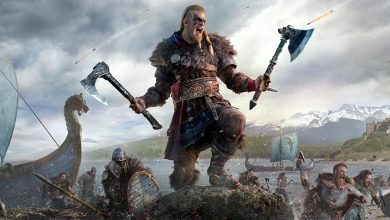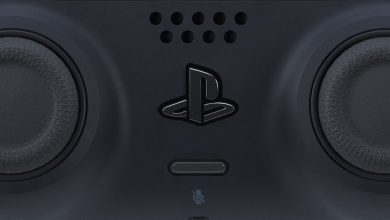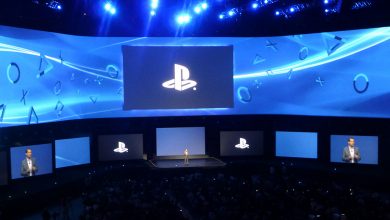Free from the limitations of a comic book license, the Infamous series has been a rare opportunity to explore a scenario where having superpowers didn’t automatically make you a superhero. You could use those abilities to help others, or become a self-serving asshole. Your great powers didn’t come with great responsibilities, and in neither of the prior two games has this been made as apparent as it is in Infamous: Second Son.
For Delsin Rowe, a spoiled and naive 20-something graffiti artist, these newfound superhuman powers are a license to escape the weight of expectations from a tight-knit native American community and his overprotective cop brother. The narrative nature of Infamous games has always had you overcoming a greater evil as the end-game, so you can’t go all-out supervillain, but there’s wiggle room to cause plenty of chaos along the way, and Delsin is only too happy to oblige.
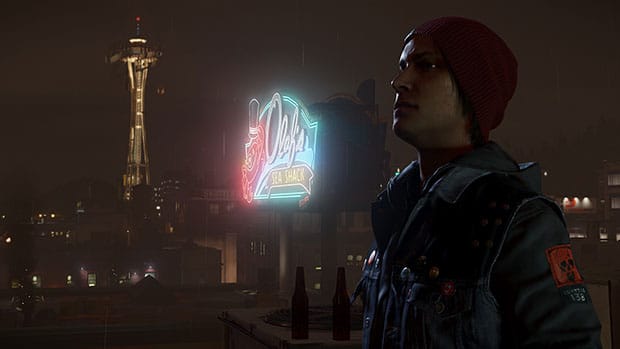
It’s got a distinct X-Men feel to it, with conduits with different powers using them for either good or evil.
Undoubtedly, one of Second Son’s biggest successes is how comfortable it feels within its narrative and its setting. The gravelly-voiced Cole McGrath didn’t quite have the personality to carry a game, and his supporting cast didn’t really help matters. Delsin, on the other hand, is a revelation, helped by great voice acting from The Last of Us’ Troy Baker. The writing is on another level – conversations between characters feel natural and effortless, and the witty banter here wouldn’t be out of place in a Naughty Dog or Rockstar game. And it really doesn’t get much better than that.
Second Son is still very much rooted in the unsuspecting-normal-guy-endowed-with-superhuman-powers premise of the first two games, and while past games made it clear that you weren’t the only one in the world with these powers, this time around, other ‘conduits’ form the basis of the story and its progression. It’s got a distinct X-Men feel to it, with conduits with different powers using them for either good or evil. Delsin, as luck would have it, is a superpower sponge, so he can simply absorb the powers of other conduits, and so you’ll have multiple powers to play around with, as opposed to just the one in previous games.
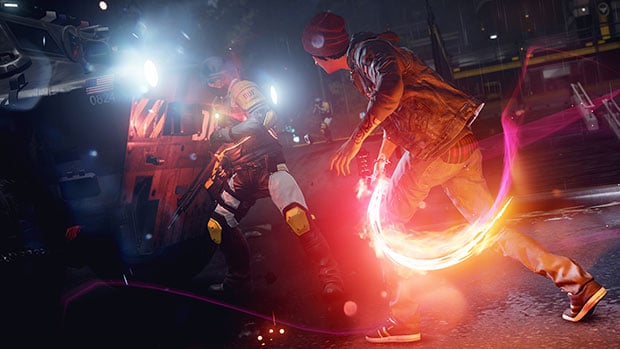
It’s the sort of freedom of movement I haven’t seen in an open-world game since Crackdown, only better.
You can’t skate across power lines (there aren’t any, in fact) or railway tracks like you could previously, and if that disappoints you, know that what you can do to get around in Second Son is infinitely more fun. Each power, be it smoke, neon, or the other ones (which I won’t spoil) has a dash move. Thanks to the dash, never will you have to climb another building; you can simply fly up the vents or run up walls. You can also dash through the air, with objects like air vents and satellite dishes on rooftops acting as ramps to propel you even higher. Where earlier you were just a passenger skating along, there’s skill, planning and foresight required now, and incorporating traversal into Delsin’s powers is a masterstroke. It’s the sort of freedom of movement I haven’t seen in an open-world game since Crackdown, only better.
You can, of course, play as the good guy or the bad guy, and once again, the impact of your choices isn’t as pronounced as you might find in some RPGs, but there’s now a distinct change in mood based on the choices you make. Each conduit you meet presents you with a moral choice – liberate them or corrupt them, and all future missions with that conduit will send you down that chosen path. Cutscenes, missions and dialogue all vary based on your choices, and the game will now reward you for sticking to your chosen play style. From simple stuff like restraining an enemy for good karma or killing them for bad karma, to levelling up your various weapons to neutralise enemies in different ways, your entire playing style can be catered to whether you fancy yourself as a superhero that everyone loves or the asshole everyone fears. This greater emphasis on choices also makes a stronger case for a second playthrough than either of its predecessors.
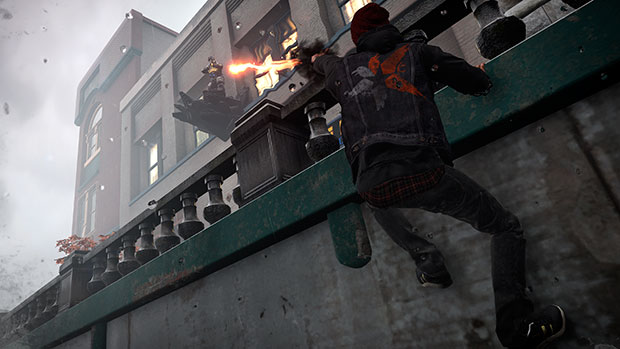
In terms of movement, traversal and combat, Infamous: Second Son simply has no match in the open-world genre.
As in previous games, Delsin has quite an arsenal at his disposal, from melee attacks, to bullet-like projecticles, to long-range missiles, and of course, special attacks. Each of these attacks can be levelled up by picking up shards from across the game world, and each attack takes a different form based on the power you currently wield. In terms of movement, traversal and combat, Infamous: Second Son simply has no match in the open-world genre, and it’s perhaps the only open-world game that you can have a blast with regardless of how interesting the story or progression system is.
That’s a good thing because story and, to a greater extent, progression are what bring Second Son down a bit. Aside from the first and last 20 percent of the game, there’s a distinct lack of plot progression, and while that final 20 percent does bring the story to a satisfying and fitting conclusion, the middle parts can become a drag, especially with the way the game handles progression. Each time you gain a new power, you’ll have to go through the same process of finding ‘core relays’ to learn new ways to use it. This involves going to various parts of the city and clearing enemies. Story missions, when you do get to them, are also locked till you clear the area of enemies, which is a bit annoying. Lots of lathering, rinsing and repeating.
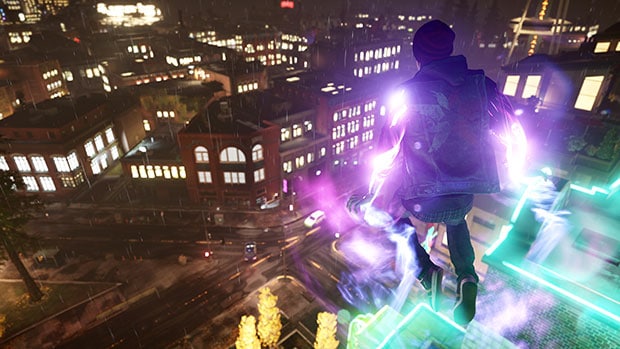
You get the feeling that Sucker Punch has focussed so much on core gameplay and production values that mission structure and progression have suffered as a result.
There’s an overall rigidity in the way the game progresses, and it’s a massive disservice to a game that is otherwise a blast to play. The missions themselves mostly consist of chases or clearing areas of enemies, occasionally throwing in a boss fight or introducing new mini bosses. There’s little variety here, and the side missions, which were a blast in Infamous 2, feel a bit of a step back too. You get the feeling that Sucker Punch has focussed so much on Second Son’s core gameplay and production values that mission structure and progression have suffered as a result.
But man, those production values! There simply isn’t a better looking open-world game out there on any platform. The crisp textures, the fantastic lighting, the free-flowing animations – there isn’t a pixel out of place. Sucker Punch has done a fine job of making the city of Seattle a sandbox you’ll want to spend hours just messing around in, so much so that this is one of the few open-world games I’ve played to 100% completion long after the story was over. There’s no better showcase of what the PS4 is capable of than Infamous: Second Son. I came dangerously close to wearing out the Share button with all the screenshots I was taking, because it just looks so good.
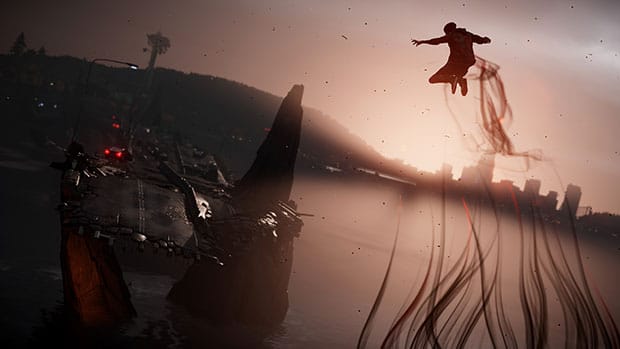
All said and done, Infamous Second Son is the very best the open-world genre has to offer in terms of core gameplay and production values. The quality of writing and the characters are also a big step forward for the franchise, and had it not been for the cookie-cutter progression and a plot that disappears for long periods, it might have found itself in the company of the very best in the genre.
Infamous: Second Son is available now at Amazon and Nextworld.

